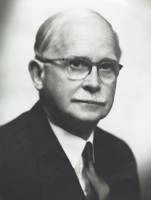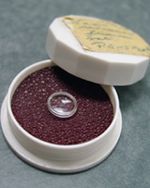 Sir Nicholas Harold Lloyd Ridley (1906-2001) was a House Surgeon and Ophthalmic Consultant at the Royal London Ophthalmic Hospital at Moorfields in 1939 when England declared war on Germany. He had already served a year in the Royal Navy and immediately joined the Emergency Medical Service.
Sir Nicholas Harold Lloyd Ridley (1906-2001) was a House Surgeon and Ophthalmic Consultant at the Royal London Ophthalmic Hospital at Moorfields in 1939 when England declared war on Germany. He had already served a year in the Royal Navy and immediately joined the Emergency Medical Service.
A year later, Germany launched the air attack known as the Battle of Britain. As part of the medical service, Dr. Ridley treated Royal Air Force pilots who suffered from eye injuries, many of which included fragments of airplane canopies made of a new material, polymethyl methacrylate (PMMA). PMMA or “Perspex” was used in the canopies of two planes in the Royal Air Force - the Supermarine Spitfire and the Hawker Hurricane. Hurricanes outnumbered the Spitfires two to one in the RAF.
During this period Dr. Ridley noted that the plastic canopy fragments were relatively inert and well-tolerated by the eye. These observations had to be put on hold, however, as World War II progressed. In 1941, Dr. Ridley was appointed a Major in the Royal Army Medical Corps and was deployed to Ghana, Africa where he studied and eventually published his findings on onchocerciasis - a tropical eye disease. A year later he was transferred to India and finally Burma where he treated the wounded from the Pacific theater and eventually wrote a paper on the role of nutrition in amblyopia.
 Dr. Ridley’s thoughts returned to PMMA after the war. While operating on a cataract patient, a resident remarked that it was a pity not to be able to replace the removed lens. This comment was the impetus for Dr. Ridley to begin thinking about intraocular lens implants and in the late 1940s he met clandestinely with John Pike of Rayner in London to discuss the design of the world’s first IOL.
Dr. Ridley’s thoughts returned to PMMA after the war. While operating on a cataract patient, a resident remarked that it was a pity not to be able to replace the removed lens. This comment was the impetus for Dr. Ridley to begin thinking about intraocular lens implants and in the late 1940s he met clandestinely with John Pike of Rayner in London to discuss the design of the world’s first IOL.
On November 29, 1949, Dr. Ridley performed the first intraocular lens implant surgery. Decades later Dr. Ridley noted, “Was intraocular surgery started a generation too soon? No, the time was both right and ripe. Immediately after a major war many were accustomed to accepting risk of injury. If implants had not started in 1949 they might have been delayed for yet another forty years.”